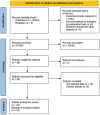A Systematic Review and Meta-Analysis of Penis Length and Circumference According to WHO Regions: Who has the Biggest One?
- PMID: 40248849
- PMCID: PMC11923605
- DOI: 10.5152/tud.2025.24038
A Systematic Review and Meta-Analysis of Penis Length and Circumference According to WHO Regions: Who has the Biggest One?
Abstract
Objective: This study aimed to perform a systematic review and meta-analysis of stretched, erect, and flaccid penis length as well as circumference according to geographic WHO regions.
Methods: PubMed, Embase, Scopus, and Cochrane Library were searched for articles published until February 2024. Studies in which a healthcare professional evaluated the penis size were considered eligible. After assessing the risk of bias, a systematic review and meta-analyses were performed according to the Preferred Reporting Items for Systematic Review and Meta-analysis statement, and the outcomes were grouped based on the WHO regions.
Results: A total of 33 studies comprising 36 883 patients were included. The risk of bias in the included studies was moderate/low. A comprehensive systematic review was done and meta-analyses performed for flaccid length [n = 28 201, mean (SE) 9.22 (0.24) cm], stretched length [n = 20 814, mean (SE) 12.84 (0.32) cm], erect length [n = 5669, mean (SE) 13.84 (0.94) cm], flaccid circumference [n = 30 117, mean (SE) 9.10 (0.12) cm], and erect circumference [n = 5168, mean (SE) 11.91 (0.18) cm]. The mean length of the stretched penis was largest in Americans [14.47 (0.90) cm]. The mean length of the flaccid penis was the largest in the Americas [10.98 (0.064) cm]. The mean flaccid penile circumference was largest in Americans [n = 29 714, mean (SE) 10.00 (0.04) cm].
Conclusions: Penis sizes vary across WHO regions, suggesting the need to adjust standards according to geography to better understand councilmen and their partners. These data provide a framework for discussing body image expectations and therapeutic strategies in this sensitive and emotional subject matter.
Keywords: Penis; circumference; length; world health organization.
Conflict of interest statement
Figures






Similar articles
-
A meta-analysis of Chinese men's penile size in a global context.Andrology. 2025 May;13(4):681-693. doi: 10.1111/andr.13727. Epub 2024 Aug 1. Andrology. 2025. PMID: 39087754 Review.
-
Worldwide Temporal Trends in Penile Length: A Systematic Review and Meta-Analysis.World J Mens Health. 2023 Oct;41(4):848-860. doi: 10.5534/wjmh.220203. Epub 2023 Feb 15. World J Mens Health. 2023. PMID: 36792094 Free PMC article.
-
Penile length in the flaccid and erect states: guidelines for penile augmentation.J Urol. 1996 Sep;156(3):995-7. J Urol. 1996. PMID: 8709382
-
Reference penile size measurement and correlation with other anthropometric dimensions: a prospective study in 800 men.Asian J Androl. 2022 Nov-Dec;24(6):620-623. doi: 10.4103/aja2021121. Asian J Androl. 2022. PMID: 35381693 Free PMC article.
-
Penile Length Measurement: Methodological Challenges and Recommendations, a Systematic Review.J Sex Med. 2021 Mar;18(3):433-439. doi: 10.1016/j.jsxm.2020.11.012. Epub 2021 Feb 27. J Sex Med. 2021. PMID: 33648901
References
-
- Lever J, Frederick DA, Peplau LA. Does size matter? Men’s and women’s views on penis size across the lifespan. Psychol Men Masculinity. 2006;7(3):129 143. (10.1037/1524-9220.7.3.129) - DOI
-
- Johnston L, McLellan T, McKinlay A. (Perceived) size really does matter: male dissatisfaction with penis size. Psychol Men Masculinity. 2014;15(2):225 228. (10.1037/a0033264) - DOI
Publication types
LinkOut - more resources
Full Text Sources
